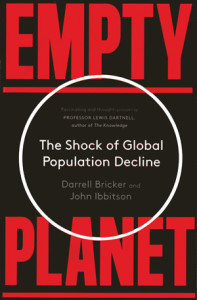Empty Planet
The Shock of Global Population Decline
by Darrell Bricker and John Ibbitson
Published by Robinson www.littlebrown.co.uk
Overpopulation has been the bugbear of civilisation from Malthus to Attenborough. Every few years a new milestone is reached – 6 billion, 7 billion, 8… UN forecasts have us on track for an 11 to 18 billion population by century’s end. How can the planet survive all those hungry mouths and carbon footprints? Well, say Darrell Bricker and John Ibbitson in ‘Empty Planet’, it won’t have to.
There are a lot of numbers in ‘Empty Planet’ but the most important one to remember is this: 2.1. That’s the number of children each woman must have on average during her lifetime to keep a population level. The authors haven’t just rounded up statistics though, they’ve done the footwork too by talking to demographic experts the world over and face-to-face interviews with focus groups on almost every continent. From immigrant workers in the US, Asian university students and Belgian young professionals to Delhi and Kenyan slum dwellers, – everywhere women have a choice, they choose to have fewer children. The authors are quite clear on the cause of this demographic shift. The economic miracles in the developing world that have lifted millions out of poverty also vacuum the young from the land into city life where children stop being hands to help and become mouths to feed.
It took Europe two centuries to go from 6 children per woman to under 2. It’s taken the developing world just two generations. Today, most of the planet has a birthrate below that magic 2.1 figure. British women have an average of 1.8 children, slightly higher than the overall European figure of 1.6. Russia’s birthrate is 1.7. America has 1.9 babies per couple (0.95 for Millennials). Chinese women have 1.6 while Thailand, Vietnam and Malaysia are 2 or less. The fertility rate in large cities such as Hong Kong, Singapore, Beijing and Shanghai is below 1. The baby booming fuel that powered the population explosion has run out and, while our numbers are buoyed by all those old folk who stubbornly refuse to die (yet), the year of ‘peak child’ has come and gone. We’ll never see that 18 billion. Not even the 11 billion. The human race, the authors claim, will peak at 9 billion some 20 to 30 years from now and then decline.
Fewer people mean less pollution and cheaper housing sure but it’s not all wine and roses warn the authors. It also means fewer taxpayers to support a graying population plus fewer workers and consumers to drive the economy. They point to Japan as a present day example. “The diminishing working population is one of the biggest causes of long term recession”, says economist Naoyuki Yoshido. Japan today, Bricker and Ibbitson say, is everywhere else tomorrow. One solution, at least for a while, is immigration. ‘Empty Planet’ paints a near future world where countries scramble to attract immigrants rather than turn them away and a US that maintains it’s economic hegemony over an ageing East by dint of it’s appeal to hungry, young workers.
It’s hard to convince people that a book on population demographics is a gripping read (not even a single graph!) but it is. On every page the authors give us hope (and the figures to back it up) that the specter of a teaming, choking, starving world that’s haunted the popular imagination of generations will soon be banished. I could argue with some of their data (which might be editorial choices rather than error) but there’s so much data. Even if some of the information is flawed, the overwhelming direction is down. If Bricker & Ibbitson are correct, people reading this book (and this review) will live to see the human population decrease. Not through war or famine or disaster, but through choice.
